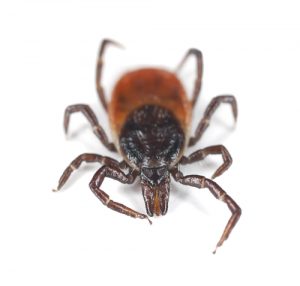Winter Tick – The Good Tick?
By Chris Williams on January 12, 2012.
I’ll be really upfront and say ‘I hate ticks’. Ticks are like little mobile biological weapons labs! Ticks are the number one disease vector in the United States and are second only to mosquitoes worldwide. They are efficient transmitters of the bacterium that cause Lyme disease, Rocky Mountain spotted fever, ehrlichiosis, and tularemia. Ticks can also carry and transmit several different viruses that cause encephalitis, and a malaria-like protozoan (Babesia microti), which causes babesiosis.
 I think its fair to say that the tick’s reputation is pretty bad when it comes to human and animal health, but are there any ‘good ticks’? Well not really, only ones (in New England anyway) that are less bad! One species of tick not implicated in transmitting disease to humans (but it will to dogs) is the Brown dog tick (Rhipicephalus sanguineus), which is not very common in NH (A. Eaton, 2009) where I live. It will rarely attack humans. The other species of tick it called the winter tick (Dermacentor albipictus). This species is closely related to the American dog tick (D. variabilis) and it is about as close to being ‘good’ as it’s going to get, because it does not transmit pathogenic microorganisms to it’s hosts. The eggs of this species hatch in spring, but the larval ticks remain inactive through the summer until the arrival of colder weather in the fall. When the young ticks become active they’ll climb up on vegetation seeking a suitable host and hikers or hunters may encounter them, but the preferred hosts for winter tick are moose, deer, and horses. Unlike its cousin American dog tick (that requires three separate hosts to complete it’s development) the winter tick completes its entire lifecycle on a single host animal before mating and dropping off to lay eggs for the next generation. Because all life stages (larva, juvenile, and adult) can be found on one host, the numbers of ticks found on any given animal can be very large. Moose that are heavily infested often develop mange and may die resulting from blood loss. Fortunately for the winter tick, self-preservation helps to keep it from killing too many of its host animals.
I think its fair to say that the tick’s reputation is pretty bad when it comes to human and animal health, but are there any ‘good ticks’? Well not really, only ones (in New England anyway) that are less bad! One species of tick not implicated in transmitting disease to humans (but it will to dogs) is the Brown dog tick (Rhipicephalus sanguineus), which is not very common in NH (A. Eaton, 2009) where I live. It will rarely attack humans. The other species of tick it called the winter tick (Dermacentor albipictus). This species is closely related to the American dog tick (D. variabilis) and it is about as close to being ‘good’ as it’s going to get, because it does not transmit pathogenic microorganisms to it’s hosts. The eggs of this species hatch in spring, but the larval ticks remain inactive through the summer until the arrival of colder weather in the fall. When the young ticks become active they’ll climb up on vegetation seeking a suitable host and hikers or hunters may encounter them, but the preferred hosts for winter tick are moose, deer, and horses. Unlike its cousin American dog tick (that requires three separate hosts to complete it’s development) the winter tick completes its entire lifecycle on a single host animal before mating and dropping off to lay eggs for the next generation. Because all life stages (larva, juvenile, and adult) can be found on one host, the numbers of ticks found on any given animal can be very large. Moose that are heavily infested often develop mange and may die resulting from blood loss. Fortunately for the winter tick, self-preservation helps to keep it from killing too many of its host animals.
So there you have it, the winter tick is the ‘good’ tick. Sort of!!